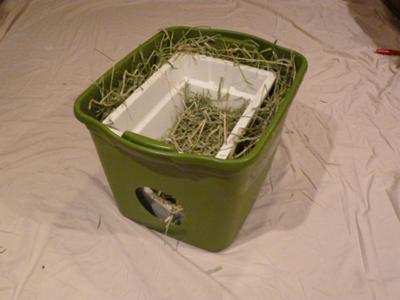by Kyle Smith
(Saratoga Springs, NY)

Required Materials
Feral cats are very resourceful at surviving most things but winter takes a harsh toll on their well-being. Cold temperatures and wind can create frostbitten ears, noses and paws.
What can you do to help the feral cat population in your area? The first thing to do; always spay and neuter your pets. Spaying not only decreases feral populations but helps your cat be happier and less stressed.
The second thing to do; spend about 20 minutes building a winter “Roughneck Home” for the cats that live in your area. Erubbermaid has created a special not-for-profit program to help feral cats survive the winter season.
Follow these directions to build your own “Roughneck Home”. Take some time to help your fellow felines. You’ll feel good and so will they. Meow.
If you build it they will come. Getting feral cats to use the homes isn’t difficult if you think like a cat.
Cats are cautious, like small spaces where they can hide. Place your home in a secluded quiet area where you’ve seen cats. Avoid open spaces, noisy populated areas, away from car fumes and chemicals and away from dogs.
Entice cats with food and water. Never place food inside a shelter that’s meant to be ‘slept’ in. Cats don’t like to sleep with food near them. Place a dish of food near the shelter to draw cats closer and boost their curiosity. If using food only visit shelter once or twice per day.
Feral cats get nervous and will avoid something that attracts too much human attention. You can also create a separate shelter for food using just the outside container with no cooler in it. Place ‘food’ shelter in the same area as but not close to ‘sleeping’ shelter.
Patience. It may take a few days to a week for feral cats to trust the new shelter. If there have been no signs of habitation after 2 weeks consider changing the location of the shelter.
What you need to build a Rubbermaid Roughneck Feral Cat Shelter.
1. Rubbermaid Container (the 18-gallon is pictured)
2. Styrofoam Cooler
3. Straw
4. Duct Tape
5. Exacto or box knife
6. Eight inch diameter pot lid or plastic lid
7. Marker of pen
8. Nail file
Make a hole in the front of container by using a marker to trace around the lid then carefully cut out hole with Exacto knife. File down any sharp edges. Place the Styrofoam container inside the Rubbermaid container. Mark inside hole by tracing around outside container with a marker. Cut out Styrofoam hole. Pack straw into the gap between the Styrofoam container and the Rubbermaid container. Place the straw inside the inner container. Place the lid on Styrofoam cooler and tape edges with duct tape then do the same with the lid on the Rubbermaid container.
For more information, step-by-step instructions and photos go to the Roughneck Feral Cat Shelter page.
The shelter pictured is an 18-gallon container, suitable for one cat or two small cats. For a larger shelter, use the 36-gallon Roughneck and a bigger Styrofoam cooler.
Additional modifications: Often, feral cats will be hesitant to enter a shelter with only one exit, since it leaves them vulnerable to predators. You may need to cut a second hole on the opposite side to encourage ferals to use your roughneck home.
For cold windy areas added protection from wind or other elements may be needed. Installing a door flap made of heavy plastic, vinyl or canvas to each entrance of your roughneck home easily does this. Cats don’t like change so its best to start your shelter with flaps rather than installing them later.
Kyle




I made a shelter using insulation panels instead of the styrofoam cooler. I placed the insulation panels on the bottom, sides, and inside the top lid. I also purchased a roll of Reflectix (insulated bubble wrap) and lined the entire inside to provide added insulation and warmth. Added the straw and my neighbor’s cat crawled in on the first day. I was so worried about him since he’s been an indoor Siamese cat for his entire life. His owner’s recently had a baby and had to put him outside. He’s been a great little companion for me, so I was very pleased to see him in his new home this morning.
Bless and well done. Although to put a cat out because they are having a baby is incorrect. All the experts say that it is unnecessary to get rid of your cat when you have a baby. Sorry to say this but it is plain incorrect and cruel.